The 5th tram route up the Ganibu Dam to the former textile factory “Bolshevichka” is well known to visitors to Riga exhibitions. For almost a decade now, larger and smaller scale events have taken place in Boļševička, starting with the 2014 Survival Kit 6. In 2015, it was possible to attend the events of the theater festival “Homo Novus”, while in 2018, the former textile factory was one of the venues of the Riga International Biennale of Contemporary Art (RIBOCA). This summer, the territory of the former factory is revived by the Latvian Center for Contemporary Art (LLMC) “Mobile Museum. Next season ”.
The exposition of the “Mobile Museum” in the territory of the former textile factory “Bolshevich”, Ganibu dambis 30, can be seen until August 29. Opening hours: Thursdays and Fridays from 14:00 to 20:00, Saturdays from 12:00 to 20:00. Free entrance.
–
–
The exhibition is a continuation of the first “Mobile Museum” created in 2007 in the hall of the Andrejsala building workshop and in the project room “Ēdnīca”, which was made in the context of the current discussion about the construction of a museum of contemporary art. He had created a sketch for the new museum star architect Rem Kolhas, who wanted to build an art center by transforming the Andrejsala thermal power plant building.
Almost 15 years have passed since Andrejsala’s “Mobile Museum”, but when and how the Museum of Contemporary Art will become in Latvia is about as unclear as at that time.
Similar to the series, where the basic setting remains, but the dramatic content can continue to be produced indefinitely, the LLMC “Mobile Museum” project has “next season” and, as the exhibition curator Solvita Krese points out: “This decades-long museum of contemporary art has become an image, such as the hero of a recognizable series, which from time to time slips into the frame of Latvia’s cultural policy. ”
Photo: Margarita Ogoļceva
–
–
Upon entering the territory of “Bolshevich”, the visitor is greeted by Artūrs Virtmanis’ illuminated arch “Tomorrow never comes”. The arch fits so organically into the architecture that has lost its production functionality that it can almost be missed during the day when it is not lit. The work greets the viewer with a message about endless expectations that run through the entire exhibition. It should also be noted at once that the works in the exhibition were originally created in other art projects. In order to be exhibited in the “Mobile Museum”, some objects had to be restored, some were exhibited in fragments, others were re-created because the original has not been preserved.
The fact that the works have had a previous life is an added value to this artistic event.
It is a great pleasure to look for the first time or again at what has happened in the relatively recent past – it seems that in the process of rapid revolution of the Latvian art environment and continuous creativity, re-presentation of works of art does not happen too often.
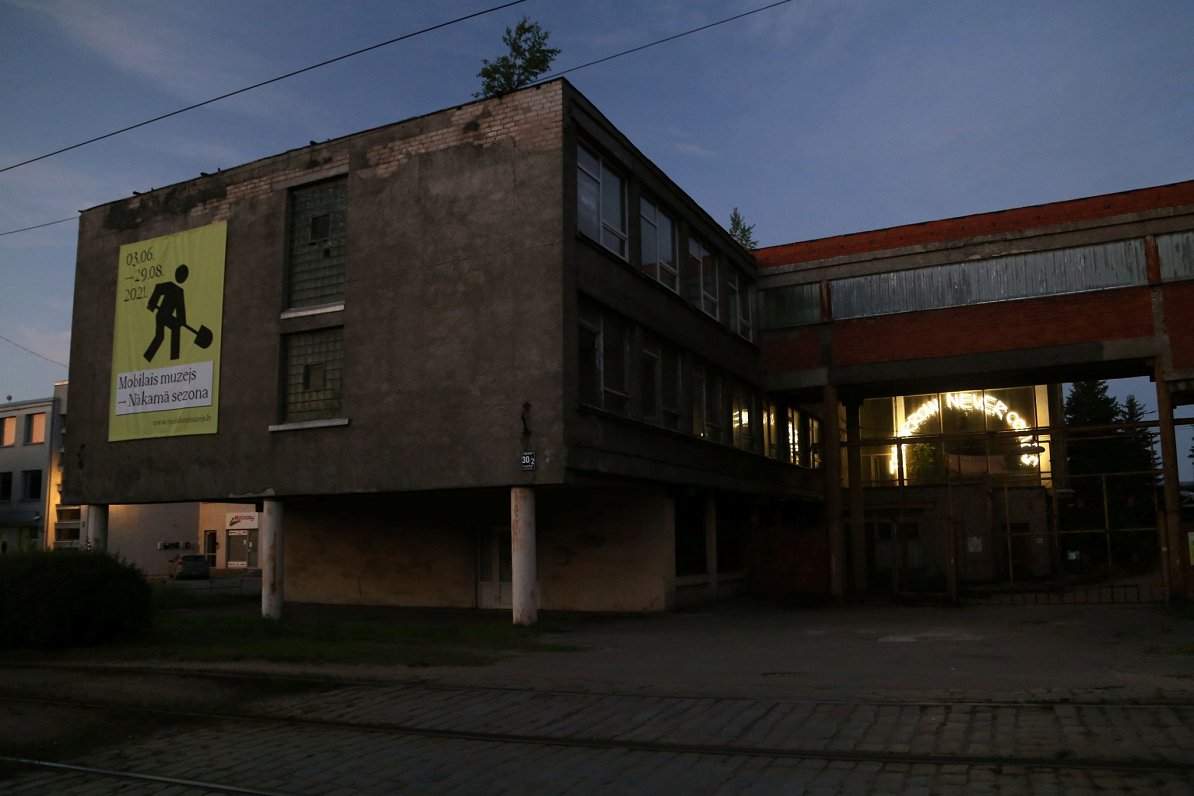
Artūrs Virtmanis “Tomorrow never comes” (2018)
Photo: Margarita Ogoļceva
–
–
For some works, the second show is almost like the first. For example, Monika Pormale’s “I Want Nothing for No Money” (2003) was originally shown for only one day. It was originally created for the art campaign “LV. TM ”(“ Latvia. Trademark ”). Text: “I don’t want anything for any money! Want nothing for no money! Call! Call! T. 7037589 ”was pasted in red letters on the windows of the glazed building at the intersection of Krišjāņa Barona Street and Raina Boulevard. The telephone number was real and at that time belonged to the curator of the exhibition Ieva Kalniņa. The work had a very short life – “I don’t want anything for any money” had to be removed the day after its installation, because the building owners complained that the bright sign threatens to cause traffic accidents. windows (with a new phone number) this time is safe for drivers, but has not lost its sharpness –
our public space is still rich in working anti-core consumer language, only now it is more difficult to distinguish between advertising and non-advertising.
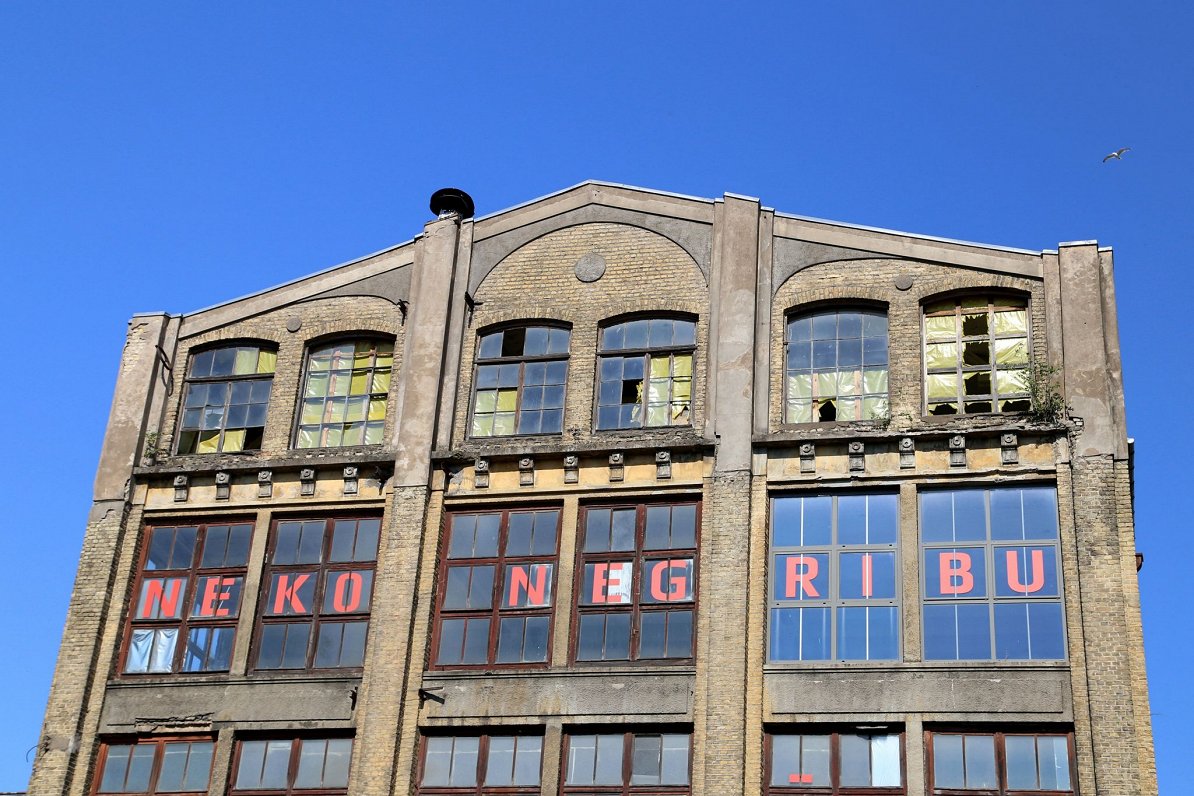
Monika Pormale “I don’t want anything for any money!” (2003)
Photo: Margarita Ogoļceva
–
–
The works of Ēriks Božs in the exhibition – “For Local Conversations” (1995) and “Guarding Sky” (2008) – also express succinctly but powerfully. “Local calls” have three telephone sheds that are much larger and taller than a human. The work was originally created for the exhibition “Monument”, where works of art were created in the urban environment of Riga instead of the former monuments, reflecting on the role of the monument as a symbol of power and ideology. I don’t know how it was seen in 1995, when it was installed in Riflemen’s Square, but looking at the “Local Conversations” from the perspective of the smartphone era, the high phone booths seem not only very funny, but also extremely high and unreachable.
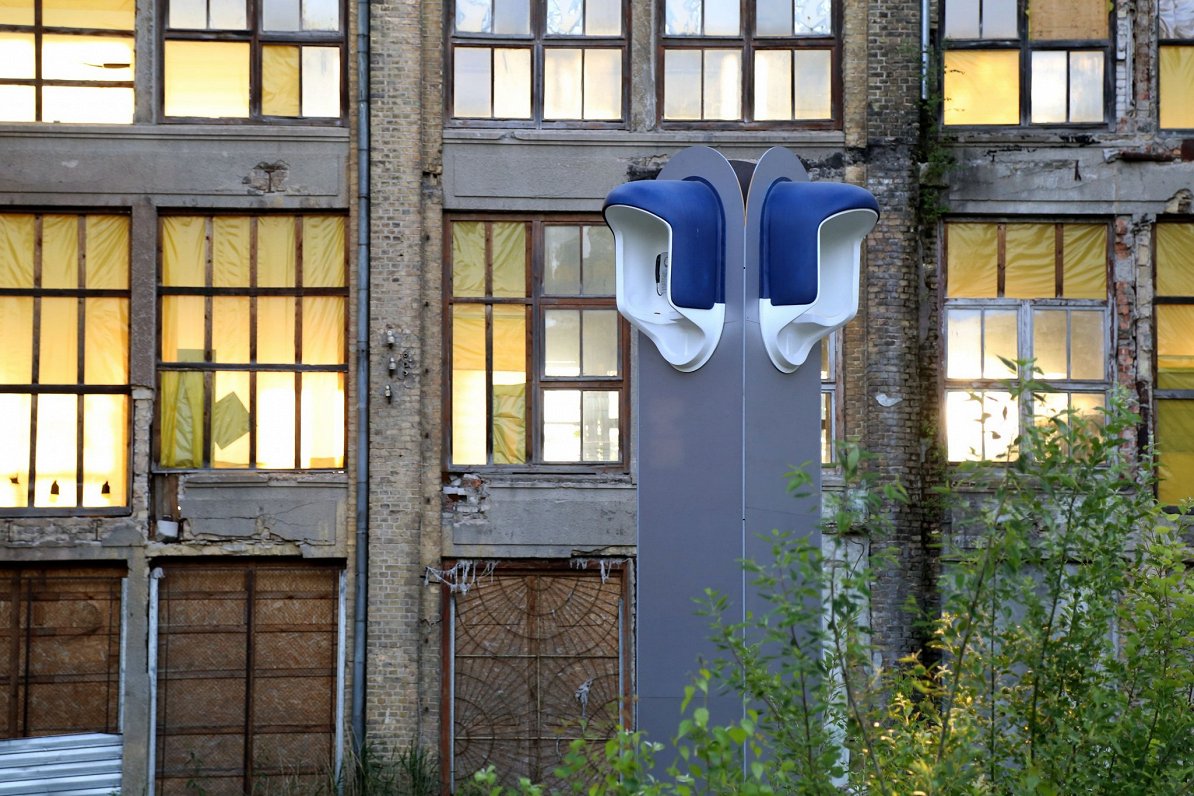
Ēriks Božis “For Local Talks” (1995)
Photo: Margarita Ogoļceva
–
–
In turn, the “Protective Sky” – a fragment of the suspended ceiling with lights – is an everyday element of the interior, installed “incorrectly” and out of place. “Protective sky” with its own design fascuda aesthetics as our living space and internal ceiling, or as Božis himself described it – a forgery “necessary for real life.”
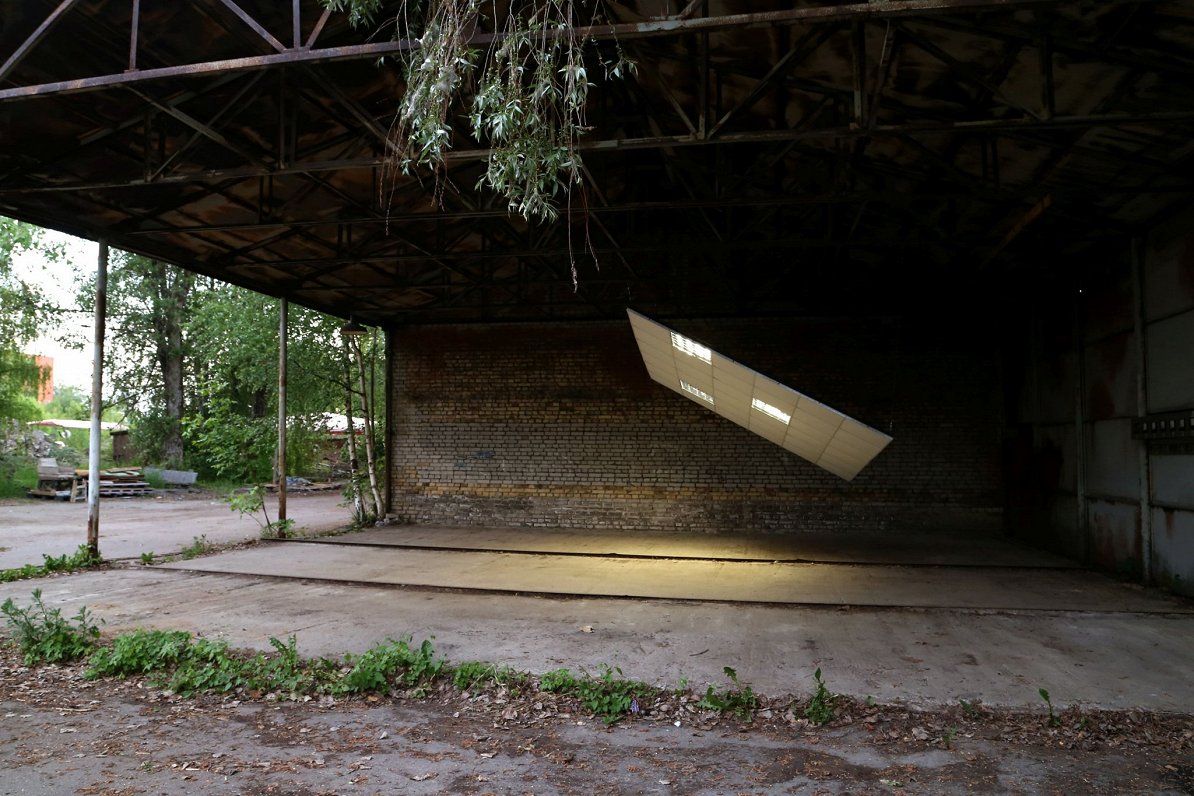
Ēriks Božis’ The Protective Sky ”(2008/2021)
Photo: Margarita Ogoļceva
–
–
The location on the former factory site makes many of the works even more immediate than would be possible in a sterile art space. Looking at Ivars Drulle’s “Rust Paintings” (2016) under the blue sky when asphalt is smoking underfoot in the summer heat,
there is a feeling that the crumbling Latvian country houses depicted in them do not fade slowly, but burn.
The author himself points out that the paintings are not static and they continue and will continue to change, ie the rusting process continues, because there are no situations in which they would not be subject to atmospheric changes. The heat and the sun are a powerful filter to look at “Rust paintings” – they seem to change at a double rate and everything, in fact, disappears much faster than we think.
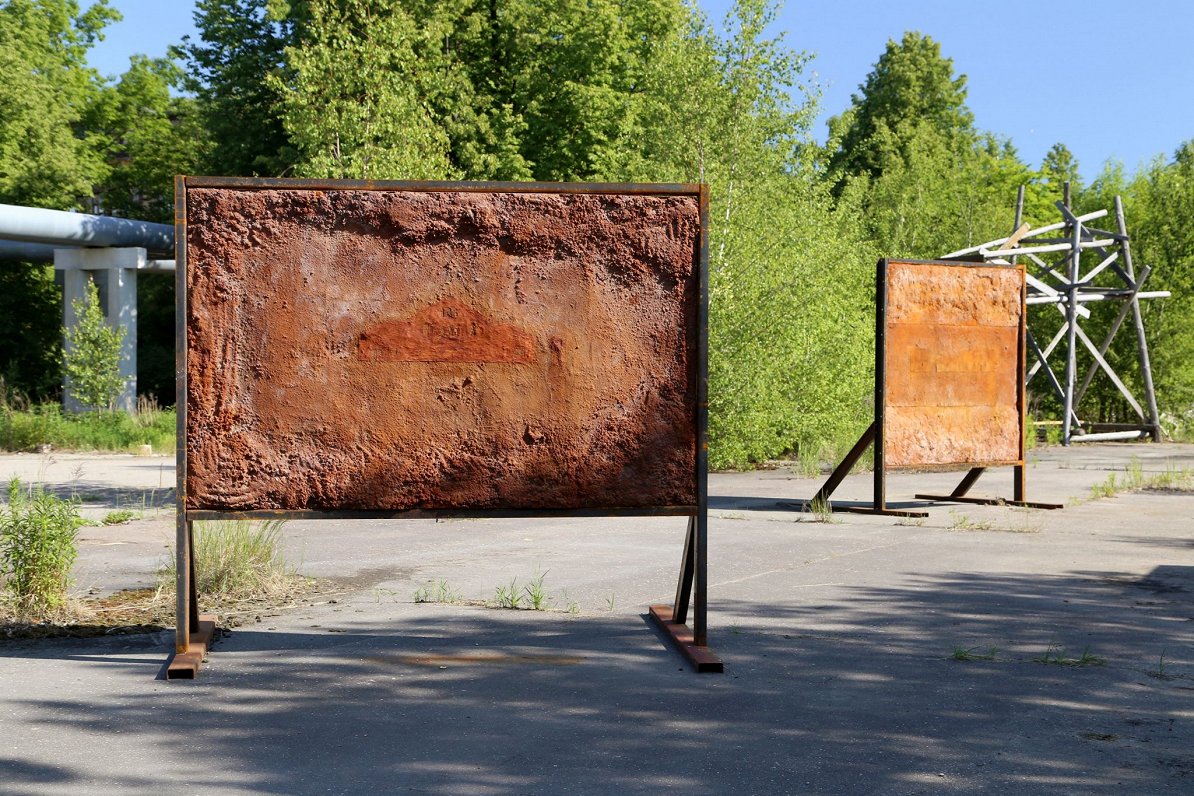
Ivars Drulle “Rust Paintings” (2016)
Photo: Margarita Ogoļceva
–
–
The work of Krista and Reinis Dzudzilo “Respice post te. Hominem te memento ”(2016), which was originally exhibited on an abandoned building in Old Riga, but the uninstallation did not survive. A new version of the work has been created for the “Mobile Museum” – the word “Memento” is placed above the white letters of the rubble pile. Bolshevich Park, where you are sometimes forgotten whether you are in the city or in an overgrown rural landfill, which is both ruins and somewhat reminiscent of a dystopian future landscape,
“Memento” with its central place in the joint exposition, reminds of the finality of our physical existence, of the mortality of all things.
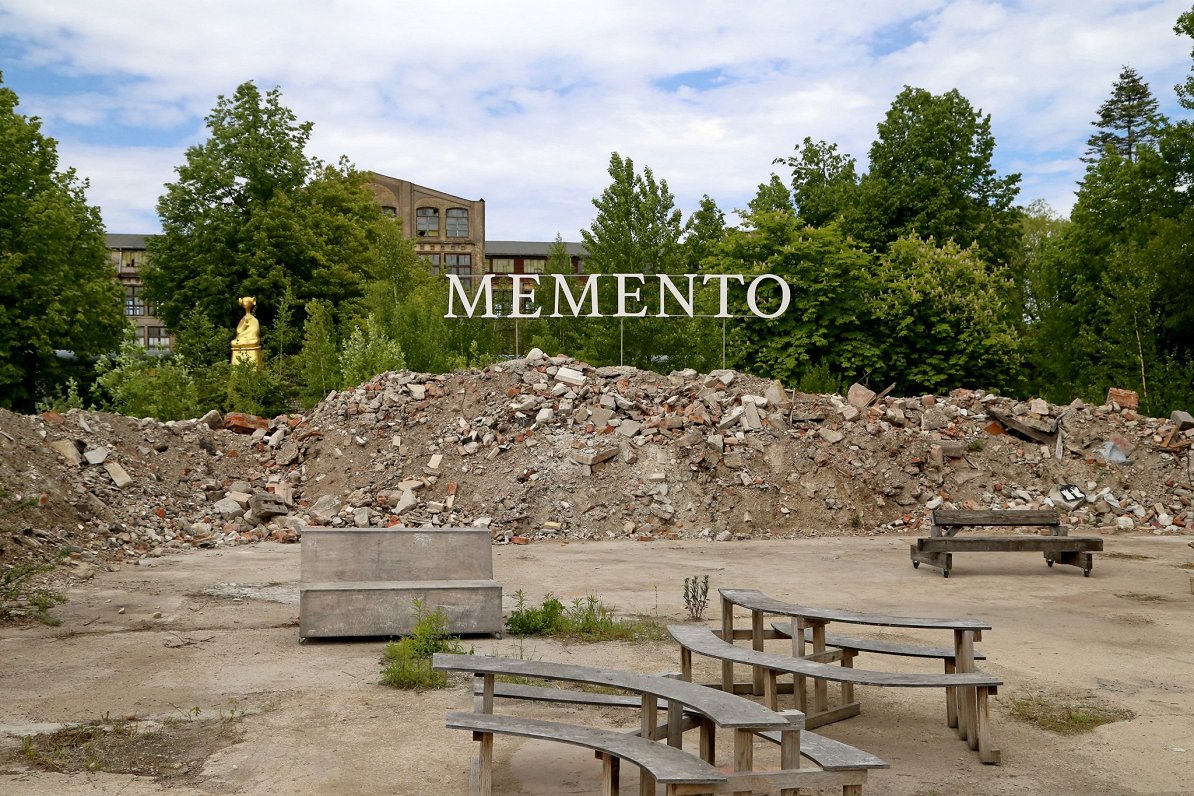
Krista un rein Dzudzilo “Look behind you. I remember a man / O “(2016/2021)
Photo: Margarita Ogoļceva
–
–
The discussion about the construction of a contemporary art museum, of course, also creates a context in which looking at the exhibition must also think about the finality of the physical objects, whose original forms are, if not completely destroyed, then more or less damaged by time and resources. lack. I really want to say goodbye “Mobile Museum. Next season ”website, which clearly contains information about the exhibited works and the documentation of their original exposition. Both the exhibition and the website are an example of how a “stationary museum” could potentially operate, which would not be a constant search for a new home. Because the “mobile museum” is an experiment in thought, not a long-term solution.
How long can someone maintain the lifestyle to which many art objects are currently exposed, where they spend one night in a five-star hotel, the next – with a friend on the couch?
To be one of the custodians of collective memory, an archive of artistic events, a catalyst for creativity, and to help prevent everything from disappearing, burning out and being forgotten so quickly – something like this can be expected from a museum with its own foundations and a roof over your head.
–

:quality(80)/cdn-kiosk-api.telegraaf.nl/79d56d34-dbc8-11eb-8613-0217670beecd.jpg)
:quality(80)/cdn-kiosk-api.telegraaf.nl/31ac69e2-dbbc-11eb-98fa-0255c322e81b.jpg)